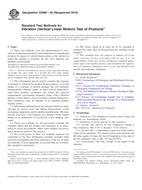Potrebujeme váš súhlas na využitie jednotlivých dát, aby sa vám okrem iného mohli ukazovať informácie týkajúce sa vašich záujmov. Súhlas udelíte kliknutím na tlačidlo „OK“.
ASTM D3580-95(2010)
Standard Test Methods for Vibration (Vertical Linear Motion) Test of Products
Automaticky preložený názov:
Štandardné skúšobné metódy pre vibrácií (Vertical Linear Motion) Test produktov
NORMA vydaná dňa 1.1.2010
Informácie o norme:
Označenie normy: ASTM D3580-95(2010)
Poznámka: NEPLATNÁ
Dátum vydania normy: 1.1.2010
Kód tovaru: NS-24133
Počet strán: 4
Približná hmotnosť: 12 g (0.03 libier)
Krajina: Americká technická norma
Kategória: Technické normy ASTM
Anotácia textu normy ASTM D3580-95(2010) :
Keywords:
dwell test, fatigue characteristics, random, resonances, sinusoidal, vibration, Dwell test, Random variables/variation, Resonances, Sinusoidal motion/vibration, Transportation vibration, Vertical linear motion, Vibration test--packaging/shipping materials, ICS Number Code 19.060 (Mechanical testing)
Doplňujúce informácie
| Significance and Use | ||||||||||
|
Products are exposed to complex dynamic stresses in the transportation environment. The determination of the resonant frequencies of the product may aid the packaging designer in determining the proper packaging system to provide adequate protection for the product, as well as providing an understanding of the complex interactions between the components of the product as they relate to expected transportation vibration inputs. |
||||||||||
| 1. Scope | ||||||||||
|
1.1 These test methods cover the
determination of resonances of unpackaged products and components
of unpackaged products by means of vertical linear motion at the
surface on which the product is mounted for test. Two alternate
test methods are presented:
Note 1—The two test methods are not necessarily equivalent and may not produce the same results. It is possible that tests using random vibration may be more representative of the transport environment and may be conducted more quickly than sine tests. 1.2 This information may be used to examine the response of products to vibration for product design purposes, or for the design of a container or interior package that will minimize transportation vibration inputs at these critical frequencies, when these products resonances are within the expected transportation environment frequency range. Since vibration damage is most likely to occur at product resonant frequencies, these resonances may be thought of as potential product fragility points. 1.3 Information obtained from the optional dwell test methods may be used to assess the fatigue characteristics of the resonating components and for product modification. This may become necessary if the response of a product would require design of an impractical or excessively costly shipping container. 1.4 These test methods do not necessarily simulate the vibration effects that the product will encounter in its operational or in-use environment. Other, more suitable test procedures should be used for this purpose. 1.5 Test levels given in these test methods represent the correlation of the best information currently available from research investigation and from experience in the use of these test methods. If more applicable or accurate data are available, they should be substituted. 1.6 The values stated in SI units are to be regarded as standard. No other units of measurement are included in this standard. 1.7 This standard does not purport to address all of the safety concerns, if any, associated with its use. It is the responsibility of the user of this standard to establish appropriate safety and health practices and determine the applicability of regulatory limitations prior to use. See Section 6 for specific precautionary statements. |
||||||||||
| 2. Referenced Documents | ||||||||||
|




 Cookies
Cookies
